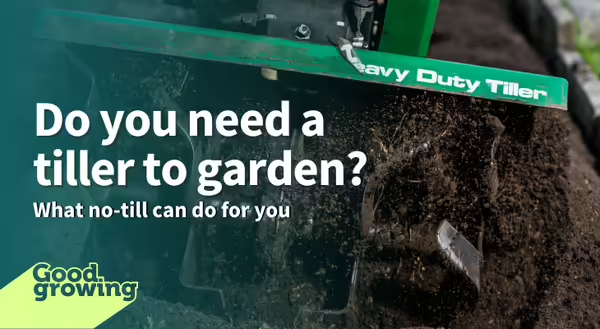
Growing up and working in my parent’s garden, I often remember the early spring when the tree buds are opening, the grass is greening up, and birds are singing. Suddenly, the roar of our massive Honda tiller broke through the serene spring day as it chewed and turned the earth and spewed exhaust into my parents' faces. At my young age, I didn’t have the mass to maneuver the behemoth machine. My mother assured me that turning the soil was better for the plants and kept the weeds down. I often questioned this statement later in the summer as I weeded the hard-crusted earth and hauled water to struggling plants.
Today there is a debate on whether we should pursue till or no-tilled gardens.
What tilling soil does
- Helps to introduce oxygen and organic matter into the soil profile
- Aids in breaking up heavy clay soil or areas that suffer from compaction.
The increased oxygen in the soil helps break down organic matter giving plants nutrients.
So why switch to no-till?
Well, tilling also destroys the structure of your soil. Loose friable soil is desirable, but be aware that opening the soil up exposes it to air and sunlight which will greatly diminish your soil moisture. Over-tilled or pulverized soil has smaller soil particles that dry out quicker, and you can easily develop a ‘crust’ on the soil surface.
And remember that oxygen we added by tilling? As microbes use oxygen to break down organic matter, we lose that organic matter in the form of carbon dioxide, a greenhouse gas. Yes, the garden gets a quick boost that first growing season, but the following years are often followed by diminishing returns. Additionally, by tilling or ‘lifting’ the soil you are exposing dormant weed seeds that will now germinate.
How to grow a no-till garden
One approach to a no-till garden is to use raised beds. Your initial efforts at constructing raised beds will be greatly rewarded with reduced labor in the long term.
Design narrow raised beds
A raised bed’s function is to define the planting space by elevating it above the ground plane. This is key because it supports the first rule of no-till gardening, you do NOT walk in the planting bed. Continuous foot traffic in a planting bed leads to increased soil compaction and thereby an increased need for tilling. Design your raised beds to be no wider than you can reach, usually 3 to 4 feet.
Raised beds can be constructed out of poured concrete, concrete block, brick, or wood. Fill your raised beds with mostly topsoil and some good commercial compost.
Mulch is a key ingredient to no-till gardening
Mulch comes in a variety of suitable forms.
- Compost or shredded leaves are options for quick biodegradable activity. These will infiltrate easily into the soil profile, reducing your need to till.
- Arborist wood chips break down slowly but work very well minimizing weed pressure while allowing water and air exchange between the atmosphere and the soil.
Luckily, our family’s gardening experiment evolved with experience and we shifted to a no-till, raised bed strategy. After more than a decade of having raised beds my parents rarely water, never till, and only have the occasional weed pop up. By adopting a no-till gardening strategy you can save water, labor, and time better spent come summertime, like relaxing in a hammock.
Good Growing Tip of the Week: Another alternative to tilling is to layer a thick (up to 12-inch) layer of woodchips in the fall where you want your garden beds. These will suffocate existing plants and have beds ready to plant the next spring.
Sign up for our emails! Want to get notified when new Good Growing posts are available? SIGN ME UP
MEET THE AUTHOR
Chris Enroth is a horticulture educator with University of Illinois Extension, serving Henderson, McDonough, Knox, and Warren counties since 2012. Chris provides horticulture programming with an emphasis on the home gardener, landscape maintenance personnel, and commercial landscapers. Additional responsibilities include coordinating local county Master Gardener and Master Naturalist volunteers - providing their training, continuing education, advanced training, seasonal events, and organizing community outreach programs for horticulture and conservation assistance/education. In his spare time, Chris enjoys the outdoors, lounging in the garden among the flowers (weeds to most).